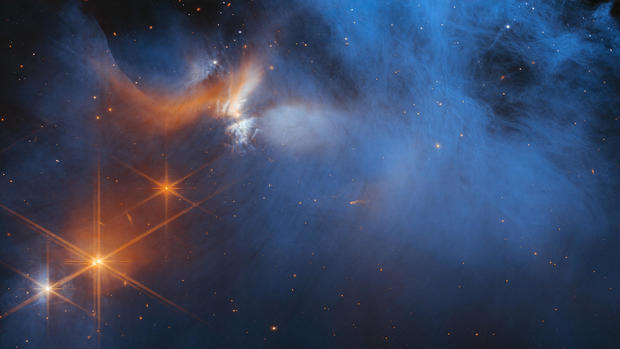Webb telescope peers into the frozen heart of a space cloud
(CNN) -- The James Webb Space Telescope peered inside a wispy molecular cloud located 630 light-years away and spied ices made of different elements.
Molecular clouds are interstellar groupings of gas and dust where hydrogen and carbon monoxide molecules can form. Dense clumps within these clouds can collapse to form young stars called protostars.
The Webb telescope focused on the Chamaeleon I dark molecular cloud, which appears blue in the new image. A young protostar, called Ced 110 IRS 4, glows in orange to the left. The journal Nature Astronomy published a study including the image on Monday.
More orange dots represent light from stars in the background, piercing through the cloud. The starlight helped astronomers determine the diverse range of frozen molecules within the Chamaeleon I dark molecular cloud, which is forming dozens of young stars.
The Webb telescope views the universe through infrared light, which is invisible to the human eye. Infrared light can reveal previously hidden aspects of the cosmos and pierce dense clusters of gas and dust that would otherwise obscure the view.
The operations center for the telescope is in Baltimore City, at the Space Telescope Science Institute on the Johns Hopkins campus.
Astronomers have used the space observatory to discover a diverse range of some of the coldest ices in the darkest regions of a molecular cloud to date. During a survey of the cloud, the international research team identified water ice, as well as frozen forms of ammonia, methanol, methane and carbonyl sulfide.
These icy molecules could contribute to the formation of stars and planets - and even the building blocks of life.
Ices can supply planets with carbon, hydrogen, oxygen, nitrogen and sulfur, which could lead to the formation of a habitable planet like Earth, where they are used in planetary atmospheres as well as amino acids, sugars and alcohols.
"Our results provide insights into the initial, dark chemistry stage of the formation of ice on the interstellar dust grains that will grow into the centimeter-sized pebbles from which planets form in disks," said lead study author Melissa McClure, an astronomer and assistant professor at Leiden Observatory in the Netherlands, in a statement. McClure is the principal investigator of the observing program.
"These observations open a new window on the formation pathways for the simple and complex molecules that are needed to make the building blocks of life."
Foundations of planetary birth
In addition to simple molecules, the researchers saw evidence of more complex molecules.
"Our identification of complex organic molecules, like methanol and potentially ethanol, also suggests that the many star and planetary systems developing in this particular cloud will inherit molecules in a fairly advanced chemical state," said study coauthor Will Rocha, an astronomer and postdoctoral fellow at Leiden Observatory, in a statement.
"This could mean that the presence of precursors to prebiotic molecules in planetary systems is a common result of star formation, rather than a unique feature of our own solar system."
Astronomers used starlight filtering through the cloud to search for chemical fingerprints and identify the elements.
"We simply couldn't have observed these ices without Webb," said study coauthor Klaus Pontoppidan, Webb project scientist at the Space Telescope Science Institute in Baltimore, in a statement.
"The ices show up as dips against a continuum of background starlight. In regions that are this cold and dense, much of the light from the background star is blocked, and Webb's exquisite sensitivity was necessary to detect the starlight and therefore identify the ices in the molecular cloud."
The-CNN-Wire
™ & © 2023 Cable News Network, Inc., a Warner Bros. Discovery Company. All rights reserved.




